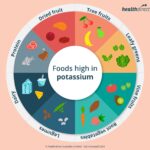If you’re managing high blood pressure (hypertension), dietary choices play a vital role in keeping it under control. The DASH (Dietary Approaches to Stop Hypertension) diet, developed in the early 1990s by researchers at the National Heart, Lung, and Blood Institute, has consistently demonstrated its effectiveness in numerous studies. This guide highlights key aspects of the DASH diet and incorporates evidence-based tips from broader research to answer the question: What Food Or Drink Lowers Blood Pressure?
4 Foods That Help Lower Blood Pressure
1. Fruits and Vegetables
Research indicates that beetroot juice may contribute to lower blood pressure. Beetroot is rich in nitrates, compounds known to have a blood pressure-lowering effect. Nitrates are also present in other fruits and vegetables like spinach, celery, kale, bananas, and strawberries.
All fruit and vegetables provide us with potassium, which can help lower blood pressure
In addition to nitrates, fruits and vegetables are excellent sources of potassium, another nutrient that can help lower blood pressure. Obtaining potassium from whole foods is preferable to supplementation. Excessive potassium intake can disrupt heart rhythm, particularly for individuals with kidney issues or those taking certain diuretics. Potassium supplements should only be taken under a doctor’s guidance.
2. Whole Grains
Whole grains, including brown rice, wholemeal bread, and oats, offer a higher concentration of nutrients and fiber compared to refined starchy carbohydrates such as white bread, pasta, and rice. Increased fiber intake is associated with a reduced risk of heart and circulatory diseases. Beta-glucans, a type of soluble fiber found in oats, can aid in lowering blood pressure. A high-fiber diet is beneficial for weight management, which, in turn, helps lower blood pressure.
- Tip: Incorporate high-fiber, starchy carbohydrates into every meal to easily increase your fiber consumption. Include other fiber-rich foods such as beans, lentils, nuts, seeds, fruits, and vegetables.
3. Lean Protein
Lean protein sources offer fewer calories than their fattier counterparts while maintaining a feeling of fullness. This aids in weight management, which is beneficial for lowering blood pressure.
- Tip: Opt for chicken, turkey, fish, eggs, and beans instead of red and processed meats.
4. Low-Fat Dairy
Including milk and other dairy products as part of a balanced diet can contribute to lower blood pressure. Dairy contains a combination of nutrients, including calcium, which is associated with blood pressure reduction.
- Tip: Choose low-fat dairy options like semi-skimmed milk and low-fat natural yogurt to obtain calcium and protein without excess saturated fat.
What Else Can Help Lower My Blood Pressure?
While diet is crucial, it’s not the only factor in managing blood pressure. Adhering to prescribed medications and implementing other lifestyle changes can also be beneficial:
4 Foods to Avoid with High Blood Pressure
Limiting or moderating consumption of certain foods can also help manage blood pressure. You don’t necessarily need to completely cut these foods out, but it’s important to be aware of your intake.
1. Salty Foods
The recommended daily salt intake is no more than 6g, or about one teaspoon. However, many people exceed this limit.
2. Sugary and Fatty Foods
Sugar and fat may not directly influence blood pressure, but foods high in these components tend to be high in calories. Overconsumption can lead to weight gain, which is associated with elevated blood pressure.
- Tip: Plan healthy snacks such as fruit or plain yogurt between meals. Carry options like nuts and dried fruit when you’re on the go.
3. Alcohol
If you consume alcohol, do so in moderation. Excessive alcohol intake can increase blood pressure and contribute to weight gain over time.
Drinking too much alcohol can raise your blood pressure
4. Excess Caffeine
Caffeine can temporarily raise blood pressure, but this effect typically diminishes with regular consumption. Moderate intake (4-5 cups daily) is generally not problematic for most individuals. However, some people are more sensitive to caffeine, and excessive consumption may affect blood pressure.
- Tip: Remember that caffeine is found not only in coffee and tea but also in energy drinks, chocolate, and soft drinks like colas.
In conclusion, understanding what food or drink lowers blood pressure involves adopting a holistic approach centered on a balanced diet rich in fruits, vegetables, whole grains, lean protein, and low-fat dairy, while also limiting salt, sugar, fat, alcohol and caffeine intake. Coupled with prescribed medications and healthy lifestyle choices, you can effectively manage your blood pressure and promote overall health.
